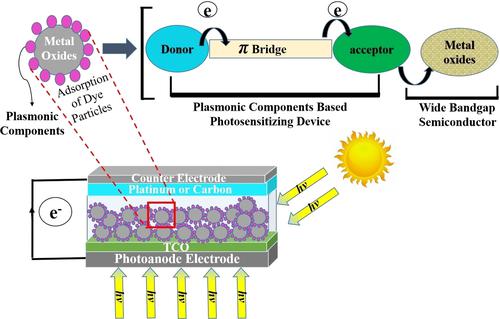当前位置:
X-MOL 学术
›
ChemistrySelect
›
论文详情
Our official English website, www.x-mol.net, welcomes your
feedback! (Note: you will need to create a separate account there.)
Plasmonic Dye-Sensitized Solar Cells: Fundamentals, Recent Developments, and Future Perspectives
ChemistrySelect ( IF 1.9 ) Pub Date : 2021-09-14 , DOI: 10.1002/slct.202102177 Hafiz Muhammad Asif Javed 1, 2 , Muhammad Sarfaraz 1 , M. Zubair Nisar 1 , Akbar Ali Qureshi 3, 4 , M. Fakhar e Alam 5 , Wenxiu Que 2 , Xingtian Yin 2 , Hisham S. M. Abd‐Rabboh 6, 7 , Arslan Shahid 1 , M. Irfan Ahmad 1 , Sana Ullah 8
ChemistrySelect ( IF 1.9 ) Pub Date : 2021-09-14 , DOI: 10.1002/slct.202102177 Hafiz Muhammad Asif Javed 1, 2 , Muhammad Sarfaraz 1 , M. Zubair Nisar 1 , Akbar Ali Qureshi 3, 4 , M. Fakhar e Alam 5 , Wenxiu Que 2 , Xingtian Yin 2 , Hisham S. M. Abd‐Rabboh 6, 7 , Arslan Shahid 1 , M. Irfan Ahmad 1 , Sana Ullah 8
Affiliation

|
The rapid depletion of fossil fuel soon would drive us to look for an alternative clean energy resources to meet the global energy demand. Several attempts have been made in recent years to improve the performances of renewable energy devices to achieve higher efficiency and to compete with conventional energy sources. Solar cells have great potential for a sustainable solution to the world energy crisis. The titania (TiO2) is the most frequently used photoanode in dye-sensitized solar cells (DSSC) but its interfacial defects and restricted optical features lead it to low performance. The advent of Au/TiO2 nanocomposite materials as photoanode in DSSC has explored new approaches in the successful optimization of renewable energy devices. The newly invented plasmonic dye-sensitized solar cells (PDSSC) also have optimized performance as well as reduced adverse effects. The fabrication of nanostructured composites with the inclusion of metallic nanoparticles is very helpful to increase the light scattering by plasmonic effects. The PDSSC facilitates the electronic transport by reducing the electron-hole recombination rates due to the surface plasmon resonance effect of gold nanoparticles anchored with titania that's why these types of cells achieved maximum attention in the current era. In this review, fundamentals, recent developments, and future perspectives of PDSSC have been discussed.
中文翻译:

等离子体染料敏化太阳能电池:基本原理、最新发展和未来展望
化石燃料的迅速枯竭很快将促使我们寻找替代的清洁能源来满足全球能源需求。近年来,为了提高可再生能源设备的性能以实现更高的效率并与传统能源竞争,已经进行了多次尝试。太阳能电池在可持续解决世界能源危机方面具有巨大潜力。二氧化钛 (TiO 2 ) 是染料敏化太阳能电池 (DSSC) 中最常用的光电阳极,但其界面缺陷和受限的光学特性导致其性能低下。Au/TiO 2 的出现纳米复合材料作为 DSSC 中的光阳极探索了成功优化可再生能源设备的新方法。新发明的等离子体染料敏化太阳能电池 (PDSSC) 还具有优化的性能并减少了不利影响。包含金属纳米粒子的纳米结构复合材料的制造非常有助于通过等离子体效应增加光散射。由于固定有二氧化钛的金纳米粒子的表面等离子体共振效应,PDSSC 通过降低电子-空穴复合率来促进电子传输,这就是为什么这些类型的细胞在当前时代获得最大关注的原因。在这篇综述中,讨论了 PDSSC 的基本原理、最近的发展和未来的前景。
更新日期:2021-09-14
中文翻译:

等离子体染料敏化太阳能电池:基本原理、最新发展和未来展望
化石燃料的迅速枯竭很快将促使我们寻找替代的清洁能源来满足全球能源需求。近年来,为了提高可再生能源设备的性能以实现更高的效率并与传统能源竞争,已经进行了多次尝试。太阳能电池在可持续解决世界能源危机方面具有巨大潜力。二氧化钛 (TiO 2 ) 是染料敏化太阳能电池 (DSSC) 中最常用的光电阳极,但其界面缺陷和受限的光学特性导致其性能低下。Au/TiO 2 的出现纳米复合材料作为 DSSC 中的光阳极探索了成功优化可再生能源设备的新方法。新发明的等离子体染料敏化太阳能电池 (PDSSC) 还具有优化的性能并减少了不利影响。包含金属纳米粒子的纳米结构复合材料的制造非常有助于通过等离子体效应增加光散射。由于固定有二氧化钛的金纳米粒子的表面等离子体共振效应,PDSSC 通过降低电子-空穴复合率来促进电子传输,这就是为什么这些类型的细胞在当前时代获得最大关注的原因。在这篇综述中,讨论了 PDSSC 的基本原理、最近的发展和未来的前景。









































 京公网安备 11010802027423号
京公网安备 11010802027423号